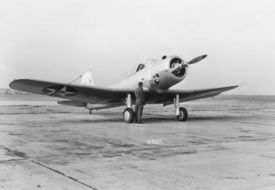PlaneSpottingWorld welcomes all new members! Please gives your ideas at the Terminal.
SB2U Vindicator
The Vought SB2U Vindicator (known as the Chesapeake in Royal Navy service) was a carrier-based dive bomber developed for the US Navy in the 1930s, the first monoplane in this role. Obsolescent at the outbreak of World War II, Vindicators still remained in service at the time of the Battle of Midway, but by 1943 all had been withdrawn to training units.
Contents
Development
In 1934, the US Navy issued a requirement for a new Scout Bomber for carrier use, and received proposals from six manufacturers. The specification was issued in two parts, one for a monoplane, and one for a biplane. Vought submitted designs in both categories, which would become the XSB2U-1 and XSB3U-1 respectively.
The SB2U was evaluated alongside the Brewster XSBA-1, Curtiss XSBC-3, Great Lakes XB2G-1, Grumman XSBF-1, and Northrop XBT-1. All but the Great Lakes and Grumman submissions were ordered into production. Around 170 of all variants were produced, and a single example is preserved at the National Museum of Naval Aviation at NAS Pensacola.
Operational history
Vindicators served on four carriers, USS Lexington, USS Saratoga, USS Ranger, and USS Wasp between December 1937 and September 1942. Air Group Nine, destined for USS Essex, trained in Vindicators aboard the auxiliary carrier USS Charger but transitioned to the SBD Dauntless before Essex joined the war.
US Marine Corps
Two USMC bomber squadrons fielded the Marine-specific SB2U-3 between March 1941 and September 1943. VMSB-241's Vindicators saw combat at Midway in June 1942.
French Marine Nationale
Based on the SB2U-2, the V-156-F incorporated specific French equipment. Briefly after the deliveries started in July 1939, one example was trialed aboard Béarn, but when the war broke out the old carrier was declared too slow for operational service. As a result V-156-F-equipped units, escadrilles AB 1 and AB 3, were based ashore when the Battle of France started. AB 1 sustained heavy losses while attacking bridges and German ground targets in Northern France, while AB 3's V-156-Fs were briefly engaged against the Italians. By the time of the Armistice, there were only a handful of remaining Voughts in French hands, and the type was phased out of service.
Chesapeakes were obtained by the Fleet Air Arm in July 1941, and used to equip a reformed 811 Naval Air Squadron whose crews referred to it as the 'cheesecake'. The squadron was intended to use them for anti-submarine patrols and was earmarked for the escort carrier HMS Archer.
By the end of October that year, it had been decided that the Chesapeakes were under-powered for the planned duties and would not be able to lift a sensible warload from the small escort carriers. Accordingly, they were withdrawn and 811 NAS was re-equipped with the Fairey Swordfish.
Description
The SB2U was of conventional low-wing tailwheel monoplane configuration, with the pilot and tailgunner seated in tandem under a long greenhouse-style canopy. Its only remarkable design feature was a propeller with reversible pitch, allowing it to be used to brake the aircraft during a dive bombing attack.
Variants
- XSB2U-1 - Single prototype.
- SB2U-1 - Initial production version. (54 built)
- SB2U-2 - (58 built)
- XSB2U-3 - Single prototype of the extended-range version, converted from the SB2U-1.
- SB2U-3 - (57 built)
- V-156B - Export version for the French navy. (24 built)
- V-156B-1 - Export version for the British Royal Navy. Also known as the Chesapeake Mk.I. (50 built)
Specifications (SB2U-2)
General characteristics
- Crew: Two, pilot and gunner
- Length: 34 ft 0 in (10.36 m)
- Wingspan: 42 ft in (12.80 m)
- Height: 10 ft 3 in (3.12 m)
- Wing area: 305 ft² (28 m²)
- Empty weight: 4,713 lb (2,138 kg)
- Loaded weight: 6,379 lb (2,893 kg)
- Max takeoff weight: 7,332 lb (3,326 kg)
- Powerplant: 1× Pratt & Whitney R-1535-96 Twin Wasp Jr radial engine, 825 hp (616 kW)
Performance
- Maximum speed: 251 mph (404 km/h)
- Range: 630 mi (1,014 km)
- Service ceiling: 27,500 ft (8,382 m)
- Rate of climb: 1,340 ft/min (6.8 m/s)
- Wing loading: 21 lb/ft² (103 kg/m²)
- Power/mass: 0.13 hp/lb (0.21 kW/kg)
Armament
- 1x forward firing .30 cal machine gun in starboard wing (.50 cal in SB2U-3)
- 1x .30 cal machine gun in flexible mount for tail gunner (.50 cal in SB2U-3)
- 1x 1,000 lb (454 kg) or 500 lb (227 kg) bomb
Operators
External link
Related content
Designation sequence
Related lists
Lists relating to aviation | |
|---|---|
| General | Timeline of aviation · Aircraft · Aircraft manufacturers · Aircraft engines · Aircraft engine manufacturers · Airports · Airlines |
| Military | Air forces · Aircraft weapons · Missiles · Unmanned aerial vehicles (UAVs) · Experimental aircraft |
| Notable incidents and accidents | Military aviation · Airliners · General aviation · Famous aviation-related deaths |
| Records | Flight airspeed record · Flight distance record · Flight altitude record · Flight endurance record · Most produced aircraft |

